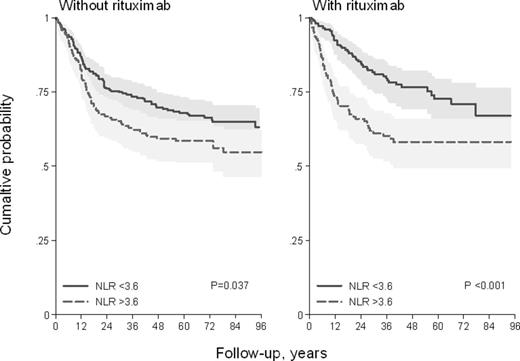Abstract
Background
There is an increasing amount of data showing that tumor microenvironment, host immunity and host inflammation response play an important role in determining the clinical course in patients with malignant lymphoma. Several investigators have considered the absolute monocytes count(AMC) as a surrogate biomarker of tumor associated macrophages, reflecting the tumor microenvironment, the absolute lymphocytes count (ALC) as a surrogate biomarker of tumor infiltrating lymphocyte, reflecting systemic host immunity, and absolute neutrophil count (ANC) as the host inflammatory response to cancer. Every of these parameters have been suggested to be a prognostic factor in diffuse large B-cell lymphoma (DLBCL). The aim of the present study was to verify whether neutrophil to lymphocyte ratio (NLR) is an independent prognostic factor in DLBCL.
Patients and Method
This retrospective analysis included data from 1050 patients diagnosed with diffuse large B-cell lymphoma according to the WHO criteria. We reviewed the clinical and laboratory data of consecutive "therapy-naïve" patients, treated in different centers in Italy and in Israel between 1993-2012, after approval by local institutional review boards.
Patients had received treatment with combination chemotherapy: cyclophosphamide, doxorubicin, vincristine, and prednisone (CHOP), CHOP-like, or third-generation anthracycline-containing regimens, with or without rituximab.
The cut-off for NLR was determined from the analysis of the log(HR) as function of NLR, by means of Cox cubic spline regression. The importance of the covariate was checked using the bootstrap inclusion frequency (BIF) with log-likelihood ratio test, considering a cut-off of 0.05, over 1000 resample of hierarchical Cox PH model, where NLR was added to IPI.
Overall survival (OS) was assessed by Kaplan-Meier estimates and compared by risk groups using the log-rank test .We also performed Cox proportional hazard analysis. The effect size of risk was reported as a hazard ratio (HR) with the associated 95% confidence interval (CI95).
Results
Out of 1050 patients, 931 (89%)were completed for IPI and NLR. The median age was 60 years (range 18-89), 53% were males and 46% received chemotherapies with rituximab as part of the regimen. The 5-yr OS% after a median follow-up of 62 months (range 1-157 months) was 65% (95CI 61-68) for the entire cohort. The log(HR) vary linearly with the log(NLR) and the cut-off was selected at 3.6. Patients with NLR >3.6 showed a worst OS compared to those NLR ≤3.6 (58% vs 69%) with HR 1.54 (CI95 1.24-1.93, p<0.001). Further, NLR showed a homogeneous prognostic role either in patients treated with rituximab or not (Figure 1). Adjusted in Cox PH regression by IPI score, NLR >3.6 maintain the prognostic value (HR 1.35, CI95 1.08-1.68, p=0.009) with a BIF of 73%. Also NLR in continuous form, log(NLR), showed a prognostic value, either in univariate (HR 1.28, CI95 1.12-1.48, p<0.001) or adjusted by IPI in multiple Cox regression (HR 1.18, CI95 1.03-1.36, p=0.021) with BIF=64%.
Conclusion
Despite the retrospective nature of the study we demonstrate that the NLR can identify high risk patients at the time of diagnosis, and that this simple prognostic factor can be utilized to improve the discriminating ability of IPI in DLBCL , irrespective of the inclusion of rituxmab in the regimen.
In conclusion the NLR is easy to obtain, readily available and can be used as a simple prognostic parameter for clinicians at diagnosis of the disease.
OS by NLR < 3.6 or NLR >3.6, in patients population treated with CHOP or CHOP like without R and in patients population treated with CHOP and CHOP like plus R
OS by NLR < 3.6 or NLR >3.6, in patients population treated with CHOP or CHOP like without R and in patients population treated with CHOP and CHOP like plus R
No relevant conflicts of interest to declare.
Author notes
Asterisk with author names denotes non-ASH members.


This feature is available to Subscribers Only
Sign In or Create an Account Close Modal